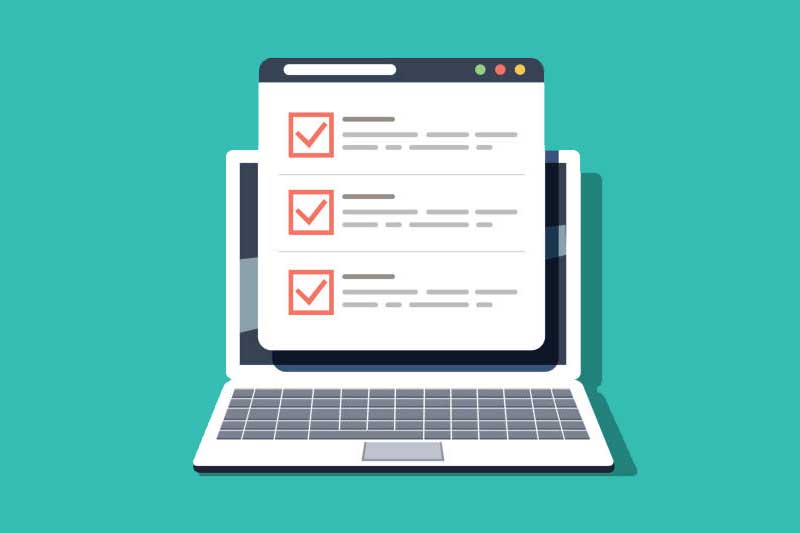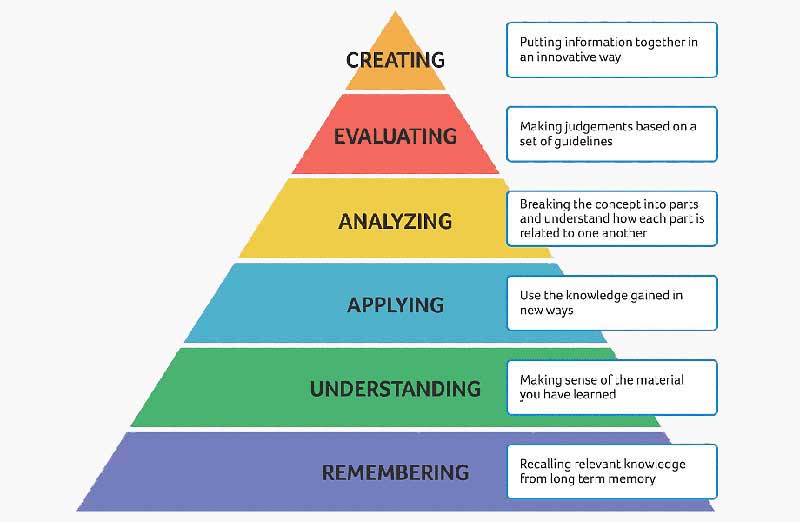Online assessments: 3 guidelines for developing great online tests
The growth of the eLearning market has led to increased competition and the consequent need to increasingly improve the content offered. So, in addition to excellent classes, instructors started creating online assessments more often to help students test their knowledge and also assess the effectiveness of the teaching material.
For those who are new to the subject, in this article we will present 3 guidelines for developing great assessments for online courses. Check out!

Why create online assessments?
More and more online courses are using quizzes and assessments to help students learn and test their knowledge.
Thanks to Learning Management Systems (LMS) and its resources, it is easier for the teacher to create online assessments. And if you think that taking tests is only beneficial for teaching and learning, take a look at the following data:
- According to a LinkedIn survey, 59% of industry experts say they use online assessments to evaluate candidates at the beginning of the recruitment process.
- 76% of organizations with more than 100 employees implement online assessment strategies for outsourcing.
- “The more senior the role, the more likely the employer is to use [online] assessments to identify candidates with the right characteristics and skills,” said Tomas Chamorro-Premuzic, chief talent scientist at ManpowerGroup.
– Benefits of Online Training for Companies
This means that online assessments have a place not only in education but also in business environments. They are useful in helping organizations improve their hiring process, recruit people, and more.
And the best part is that you don’t need to buy complex software to create assessments online, there are many free tools on the internet to help you develop tests and quizzes well-structured.
– 10 free programs to create online assessments
3 guidelines for creating online assessments
Despite the ease that various software offer to create online assessments, it is important to plan well what will be developed, because technology cannot improve something poorly designed.
While we can’t define everything that’s needed to develop good online assessments, we’ve listed three guidelines for your tests to be credible, fair, valid, and transparent.
1. Remember before, during and after
Assessment doesn’t just happen after a course or module, it can (and should) happen before, during, and after learning the content.
Cipriano Carlos Luckesi, a reference in learning assessment, states that, “the act of assessing is not an imposing act, but a dialogic, loving and constructive act”. According to him, evaluating is not measuring knowledge, and he emphasizes the importance of valuing student learning, proposing the evaluation of learning and not the evaluation of results.
Assessment must be part of the teaching-learning process, and Luckesi reports on the types of assessment, with the need to perform not only one type, but preferably several.
It is proposed that assessment has a triple function – diagnostic, formative and summative – which helps to assess where students are before, during and after learning.
- Diagnostic assessment: its function is to identify something that students have not learned in previous periods, recover what they managed to assimilate, and work so that this student can advance in the teaching-learning process.
- Formative assessment: it is carried out throughout the course, with the aim of verifying if the students are reaching the foreseen goals.
- Summative assessment: carried out at the end of a course, term or teaching unit, and consists of classifying students according to previously established levels of achievement, generally with a view to their promotion from one grade to another.
You don’t have to follow this method, of course, but remember the importance of creating multiple online assessments for each step of your course so that you can fully track your student’s progress.
– How to Create a Successful Online Course
2. Create assessments with clear objectives
Assessments should really be on how to measure learning outcomes. And learning outcomes should be about students demonstrating what they know and, more importantly, what they can do (skills).
These results can be low-level (remembering information) or high-level (analyzing information). A great time-tested resource to help us understand the various levels of learning that we can assess is Bloom’s Taxonomy.
Bloom’s Taxonomy serves to define learning objectives and plan classes based on this identification, respecting the hierarchy of educational objectives.

Teachers can plan their lessons and assessments by integrating modern technology with Bloom’s Taxonomy. This not only gives students clearer expectations, but also gives the educator a less biased method of evaluating student work.
3. Choose the right tool to assess the right skill set
There are many different types of assessments, from quizzes to seminars, from performance-based assignments to rehearsals, and so on. Each of them has a specific function and can be appropriate or inappropriate depending on what we want to assess. So choosing the right method when creating online assessments is critical.
The most common types of evaluation methods and their goals are:
- Objective test: measures how much the student learned from the specific information of the content transmitted in class, good for remembering/recognizing facts.
- Dissertation: stimulates the student to establish relationships between information, data and content, summarize, analyze, judge, establish relations of priority, rank, etc.
- Group work: it assesses how the student relates to his colleagues, whether he can divide and carry out certain tasks, how he behaves when having to share information and help other people.
- Debate: encourages students to show their point of view and defend a certain idea based on arguments built with what they learned in class. The debate also has a fundamental role in making the student listen to positions contrary to their own, respecting those who think differently.
- Seminar: aims to deepen the student’s involvement with a giventopic and encourage him to talk about it in the presence of others. It is an effective way to assess the methodology adopted by the student (or a group) to bring the researched content to the public.
- Report: is a text produced by the student right after carrying out specific thematic activities or projects. It works as a great indicator of the point at which students are in understanding the content being worked on.
- Self-evaluation: the method requires students to speak or write about their own learning process, encouraging self-criticism. It places the student as the protagonist of their own learning as they will have to reflect on what they learned over a certain period.
Attention to multiple-choice tests
In the objective test category, there are the beloved multiple-choice tests, ubiquitous in distance education. There’s just one problem, it’s not easy to create online assessments of this kind.
Here are some guidelines for developing effective multiple-choice tests:
- Ask a question and keep it brief.
- For more complex questions, the sentence should contain more information, but it should still be brief.
- Give straight answers, no extra information and meaning. The student should never be able to guess the correct answer from the way it is written.
- Do not use “All of the above” or “None of the above”. These alternatives reward students who don’t know the answers. If you need to use “None of the above”, do so carefully. Experts say this option should only be correct 1 in 4 times.
- Make sure all your answers – the correct answer and the distracting factors (the wrong answers) – are consistent in size, style, etc. We don’t want students to get the right answer because it looks different from the wrong ones.
- Pay attention to the language. Avoid errors in grammar, spelling, and mechanics that can make it difficult for students to even determine what possible answers are saying.
- Avoid categorical terms – always, never. There is no such thing as “always” or “never”, and this is an offer.
- Distractors (incorrect statements) should illuminate students’ common misperceptions. We want to be able to differentiate between high, medium and low level performances. So we really have to pay special attention to how we build them.
- Use 4 possible answers, not 3. Three increases the likelihood that students will guess the correct answer.
- Each question must be autonomous. Do not list or connect questions. We want to avoid “double risk” where if a student answers a question incorrectly, another answer will also be incorrect.
Finally, remember that the purpose of a test is to find out what students really know, rather than helping them to “false” success.
Create quality online courses and attract more students

Creating online assessments is not the simplest task. They should be linked to learning objectives and instructional activities.
Tests of all kinds require precise language, many revisions, and a clear purpose. Above all, we need to use this tool to measure the right skill. Without these practices, even the best technology won’t save a poorly designed assessment.
Using online questionnaires in distance education allows you to create classes more dynamic, involving students at the same time that you value their knowledge.
– To do list to create online courses
Evaluation created, just choose the best platform to host your content, so that your audience can have easy access to the material.
ELearning platform (LMS), Coursify.me has all the necessary features for you to integrate and import content from your computer, Dropbox, as well as channels such as Vimeo and YouTube.
– Whats is a Learning Management System
In addition, Coursify.me now has an Online Exam Module that simplifies the process of creating, implementing, administering and correcting tests.
With this feature, instructors can now easily design a variety of question types, set the pass rate, and monitor their students’ performance.
Students can take the tests remotely, receiving immediate feedback and results, which improves the overall assessment experience and supports continuous learning.
Instructors can create as many exams as they want, and they will appear in the curriculum of each module of the course, being a difference for online school.
Present in more than 60 countries, Coursify.me is a complete, dynamic and customizable teaching platform.
To learn more,visit our website and discover all the features that our platform offers to create and sell quality online courses.

